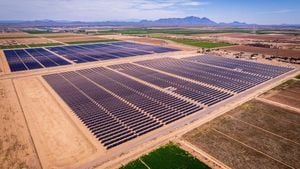Tropical Depression Sara has made headlines this week as it shifts from being a powerful storm to merely impacting regions across Central America and heading toward Florida. After unleashing significant rainfall across countries like Honduras and Belize, it now stands poised to influence weather patterns along the U.S. Gulf Coast.
Initially forming as Tropical Storm Sara, it made landfall on Sunday, November 15, causing catastrophic rainfall across its path, particularly focusing on Honduras. Some areas reported rainfall as high as 40 inches, creating life-threatening conditions. Reports indicate severe flooding and mudslides affecting many communities. Local authorities are grappling with the aftermath, and extensive flood damage remains a pressing concern. The system was placed under the supervision of the National Hurricane Center, which provided updates on its progression.
By midweek, Sara had weakened significantly and was downgraded to tropical depression status. According to the National Hurricane Center, its maximum sustained winds dropped to 30 mph as it moved over land. The storm’s impact may not have ended there, as analysts stress this banished system continues to harbor significant moisture.
"Sara's moisture is expected to push northeastward over the Gulf, possibly leading to torrential downpours for parts of Florida this week," stated Alex Sosnowski, senior meteorologist at AccuWeather. With the remnants of the storm combined with an incoming cold front, areas from Louisiana to the Florida Panhandle should brace for wetter than normal conditions starting Tuesday.
This weather combination could bring rain amounts varying by location, with concerns about flash flooding potentially developing as moisture levels rise. Weather models predict drier conditions following the storm, with temperatures expected to dip significantly as cooler air sweeps over the southeastern states by the weekend.
Although the storm's forecast path may lead to some disruption, particularly for cities still recovering from previous hurricane damage, authorities report currently no coastal watches or warnings are active inbound as the storm readies itself for interaction with the colder air mass, which is known to hamper storm development.
Despite preliminary predictions of potentially severe consequences, the storm’s transformation means Florida may only see elevated chances of rain and tropical moisture by midweek instead of extreme weather patterns. Community members are advised to keep tabs on weather updates and remain vigilant but reassured, as the storm’s intensity is expected to remain low.
Meanwhile, as Central America begins to recover, the effects of Sara cannot be understated. Reports following the storm's passage indicate severe weather destruction, insisting the region continues to experience life-threatening conditions. The toll on local populations and infrastructures is still pouring out, as officials aim to manage the fallout.
Multiple communities remain on high alert for the possibility of dangerous reflect flooding. The remaining threat doesn’t end with the storm's dissipation; weather models suggest it will continue to affect states along the Gulf Coast of the USA, foreboding potential rainfall starting this week whenever conditions are at their most favorable.
Already grappling with drier air conditions, East Coast residents are preparing themselves for the moisture-laden clouds brewing on the horizon. Sarah’s progress is closely monitored, ensuring any weather-related disruptions are swiftly communicated to the community.
From centralized advisories to local newsletters, there is heightened awareness of how Tropical Depression Sara’s path now moves away from the catastrophic flooding metrics seen previously, giving way to cautious anticipation of midweek rainfall. Residents are encouraged to stay equipped, monitor local forecasts, and review emergency preparations if necessary.
Looking back, Sara’s impact could very well join the list of other storm systems faced during the whirlwind hurricane season. Following this year's series of destructive storms—including the previously mentioned hurricanes Helene and Milton—the last few months have been especially pivotal for awareness of storm preparedness.
While the storm’s current form may not pose as imminent danger to the populace, these systems mustn't be dismissed—each weather event carries the potential for unforeseen conditions. Forecasters continue to provide updates as forecasted paths shift or adapt, reminding communities the importance of readiness for whatever nature throws their way.
Encouragement from meteorologists includes self-checks on home preparedness, environmental awareness along with caution against complacency. The collective experience over these recent months has instilled a greater vigilance among residents across affected regions. With season's end looming at the end of November, communities continue doing strategic assessments on their hydrology infrastructure and future weather thresholds.
Hurricane and storm activity each year underlines Florida's unique weather dynamics—where fluctuated water temperatures pair with cold fronts to produce fluctuated storms. The interaction of natural forces as witnessed with Sara should remind residents of the inherent unpredictability of weather conditions native to the Southeastern region.
While local forecasts promote coverage strategies aimed toward minimal disruption, residents are well-versed to logically challenge the unpredictability surrounding the Atlantic's infamous hurricane season. They remain engaged, taking their cues from the experts guiding them through these unpredictable weather patterns.
Despite the havoc recently wreaked across central America, the collective focus now shifts to the Gulf Coast ramifications. Much remains to be discovered as the remnants of Sara float northward, with forecasters forecasting its liquid remnants reshaping regional weather patterns, reigniting discourse on climate resiliency and the adaptive behaviors of affected communities.



